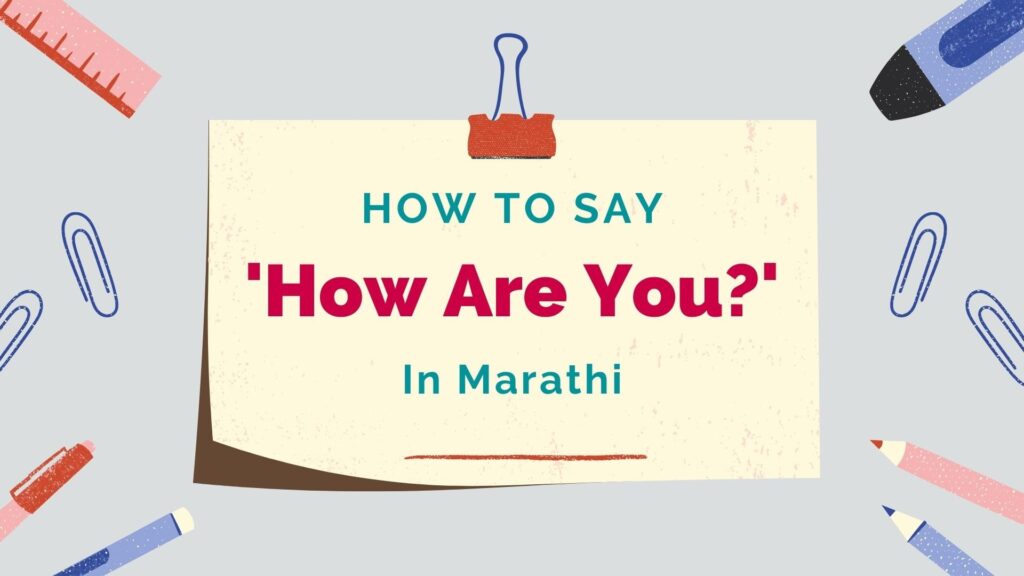How Are You Meaning in Marathi:- When it comes to languages, each one holds a unique charm, reflecting the rich tapestry of cultures and histories that shape our world. One such captivating language is Marathi, a prominent Indian language spoken predominantly in the state of Maharashtra. In this article, we delve into the intriguing question of “How are you?” and it’s meaning in Marathi, shedding light on the cultural context and linguistic subtleties that make this simple phrase much more than meets the eye.
Table of Contents
Unraveling the Greeting
The Commonality of Greetings
Greetings play a fundamental role in human interactions, serving as a bridge to connect individuals across diverse backgrounds. In Marathi, the equivalent of “How are you?” is “तू कसा आहेस?” (Tū kasa āhes?). Just like in English, this question serves as a friendly conversation starter, allowing people to check in on each other’s well-being.
The Deeper Layers
In any language, phrases often carry layers of meaning, influenced by cultural norms and societal nuances. In Marathi, asking “तू कसा आहेस?” goes beyond a mere inquiry about one’s physical state. It reflects a genuine concern for the other person’s overall condition, encompassing both physical and emotional well-being.
The Cultural Context
Community and Togetherness
Marathi culture places a strong emphasis on community and togetherness. When asking “तू कसा आहेस?”, individuals are not only inquiring about health but also expressing a sense of connection. It’s a way to show that you care, forging deeper bonds and nurturing relationships.
Politeness and Respect
Respect is a cornerstone of Indian culture, and greetings are no exception. Addressing someone with “तू” (tū), the informal singular form, denotes familiarity and closeness. On the other hand, the formal equivalent “आपला” (āplā) is used to show respect. The choice of words reflects the relationship between the speaker and the listener, adding an extra layer of meaning to the greeting.
The Linguistic Nuances
Pronunciation and Intonation
As with any language, the way a phrase is spoken can alter its meaning. In Marathi, the intonation and emphasis placed on different syllables can convey various emotions. A cheerful tone might indicate genuine interest, while a softer tone could express concern and empathy.
Embracing Marathi Identity
The question “तू कसा आहेस?” carries a sense of cultural identity and belonging. When someone uses this phrase, they are not only communicating in Marathi but also embracing the essence of the language and its heritage.
Preserving the Essence
Inclusivity in Language
Languages are living entities, evolving with time. However, preserving the essence of greetings like “तू कसा आहेस?” is crucial to maintaining cultural authenticity. As society modernizes, holding onto these linguistic traditions becomes a way to honor the past while moving forward.
A Universal Embrace ( How Are You Meaning in Marathi )
While Marathi is spoken primarily in Maharashtra, its reach goes beyond geographical boundaries. In a globalized world, the warmth of this greeting has the potential to bridge gaps and foster understanding among people of different backgrounds.

Conclusion
In the tapestry of languages, each thread weaves a unique story, connecting generations and cultures. The seemingly simple question “तू कसा आहेस?” holds within its layers of meaning—caring, respect, and a sense of belonging. As we continue to celebrate linguistic diversity, let us also embrace the cultural nuances that make each greeting a special expression of humanity.
FAQs About “How Are You?” in Marathi
- Is “तू कसा आहेस?” the only way to ask “How are you?” in Marathi? No, there are other variations like “तुम्ही कसे आहात?” (Tumhī kase āhāt?) and “तुम्हाला कसे आहे?” (Tumhālā kase āhe?).
- Can “तू कसा आहेस?” be used in formal settings? While it’s generally informal, using the respectful form “आपला कसा आहे?” (Āplā kasa āhe?) is more suitable for formal situations.
- Are there any non-verbal cues associated with this greeting? Yes, maintaining eye contact and a warm smile while asking the question enhances its genuine and caring tone.
- Is Marathi only spoken in Maharashtra? While Maharashtra is its primary location, Marathi is also spoken by communities across India.
- What are some other common greetings in Marathi? “नमस्ते” (Namaste) is a widely used greeting that translates to “Hello” or “Greetings.”







